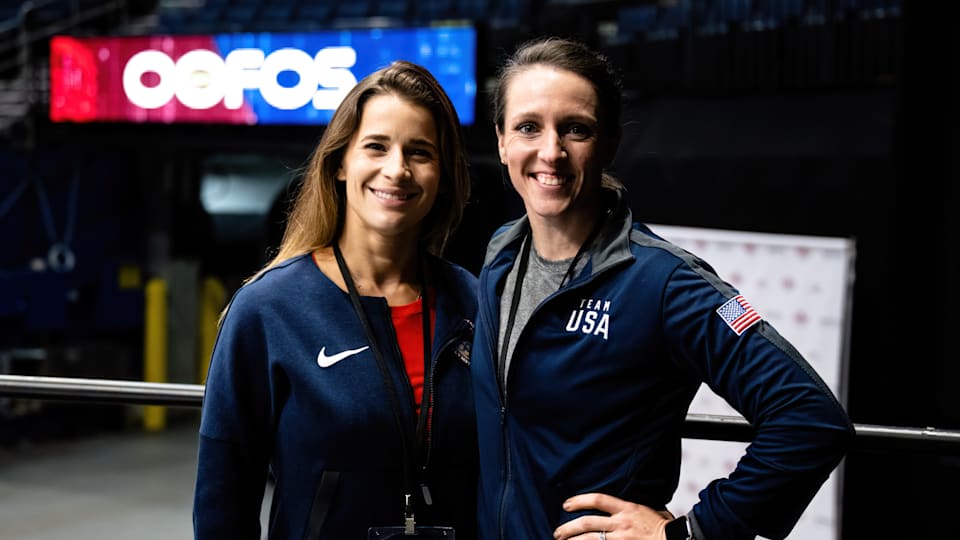
One year into their tenures as the U.S. women’s gymnastics team leaders, 2008 Olympic silver medallist Alicia Sacramone Quinn and Chellsie Memmel are focused on a more personal approach with the squad.
Taking over the reins of a successful team – let alone one as dominant as the U.S. women’s gymnastics team, which has won Olympic team gold in two of the last three Games and record-setting six, consecutive world team titles – is a daunting task.
But as the sport’s culture began to reveal itself to the public following the Rio Games, so, too, did the need for change.
“I think I’m trying to find new ways to evolve,” said Sacramone Quinn, the program’s strategic lead in an exclusive interview with Olympics.com. “Just kind of game planning and trying to be creative and come up with new ideas that can help grow our program and just try to be a little bit different than what we’ve done in the past.
“Because, yes, it works,” she continued, “But just because something worked in the past doesn’t mean it can’t be better.”
The U.S. women’s program has dominated the global scene for more than a decade. In addition to its team accolades, American women have claimed the all-around title at each of the last five Games, dating back to 2004. At the Worlds, six American women have combined for 10 of the last 14 all-around golds.
That streak started back in 2005 when Memmel, now the technical lead, stood atop the world, and it was, according to Sacramone Quinn, a time with a very different relationship between the team leadership and the athletes.
“When I was an athlete, there was a very clear divide. It was the athlete and the coach, and then the coach and [long time national coach] Martha Karolyi or the staff,” explained Sacramone Quinn. “So, a lot of that was a trickle down effect.”
She and Memmel are taking a more direct approach.
“We set up individual meetings of the athletes with their personal coach,” said Memmel, referencing the April national team camp. “I got to learn a lot more about each athlete because it’s really hard when you’re in the gym. I’m not going to try to strike up a conversation when they’re trying to concentrate on their gymnastics because that’s just silly.
“But, to get feedback directly from them was very helpful,” she continued. “My brain was just buzzing on, ‘Okay, could this be something we change? Is this what’s best for the team? How many athletes gave me that same kind of feedback?’”
Memmel says it’s also a chance to better understand each athlete’s aspirations.
“I got to hear their goals, directly from them,” she said. “Even though we sent out the survey and even though they had answered them, I still liked to ask and hear them say it because that makes a difference.”
Sacramone Quinn, who is currently on maternity leave but still in daily communication with Memmel, she says, agreed.
“I think having that dialogue with the athlete one-on-one, it’s something that helps you build that mutual respect,” she said. “You can be like, ‘Okay, this is where I feel you need to work on and where I think you’re thriving.’ We’re trying to get to know them on a more personal level to help figure out what makes them successful and help them thrive.”
The duo, who also work with developmental lead Dan Baker, are also hoping open, clear communication with the judges' rules will help the team.
They’ve been focusing on improving Team USA’s overall artistic components, something that the International Gymnastics Federation has put a major emphasis on in recent years.
Memmel, a brevet-rated judge, has been clear she knows many U.S. athletes have been receiving major deductions for not hitting the requirements.
But as they work to improve the squad’s presentation on balance beam and floor with extra rotations for beam artistry and dances choreographed by 1992 Olympic team bronze medallist Betty Okino, Memmel and Sacramone Quinn realised all the gymnasts might not fully understand the criteria under which they’re being judged.
“I think the best thing we did was, Chels and I, we lined them up, and we went through each artistry deduction of what it looked like. I don’t think the athletes knew. So, ‘elongation,’ some of them were probably like, ‘Whatever, I don’t know what that means,’” said Sacramone Quinn. “So, we stood up there in front of them going through each and every [artistry deduction]. I think that was very beneficial for them to actually see what it supposed to look like.”
And with Memmel, who often judges the routines herself, they can get instant feedback.
“When we’re at camp, we take the page from the FIG artistry and I follow up with the judges as we’re sitting and judging, ‘What did we all take for?’ So, then, the coaches and the athletes can see the information right away,” said Memmel. “Like, ‘We’re still taking this, we’re still taking this, but this is where you improved.’ I think to get that instant feedback and to see it on paper, in black and white, is very helpful.
Memmel and Sacramone Quinn have made other, more technical changes including revamping the warmup, which Sacramone Quinn says had been the same since her days on the U.S. team, and challenging the team with different pressure situations on the balance beam, an event that has given the U.S. women some issues in recent competition.
But, in the end, the focus remains the same as it was a year ago: that the leadership of the U.S. team sees their athletes as more than their abilities and accomplishments, more than the medals they may win.
"The athletes are definitely what pulls at my heartstrings and the real reason why I took this job to begin with," said Sacramone Quinn.
